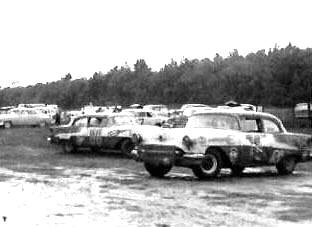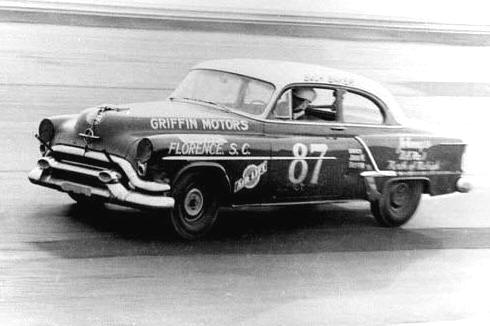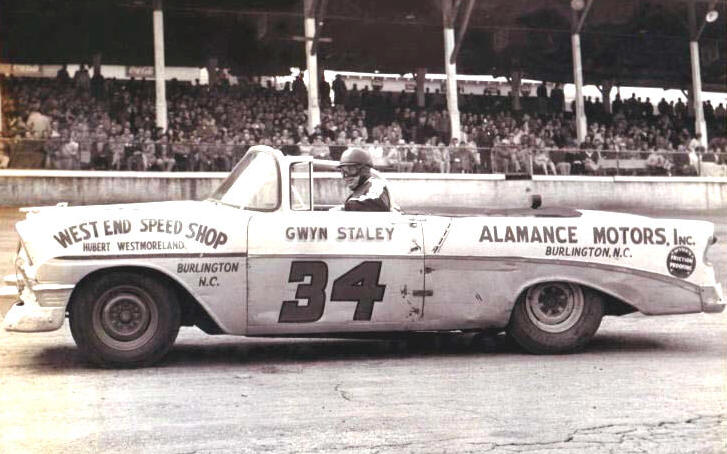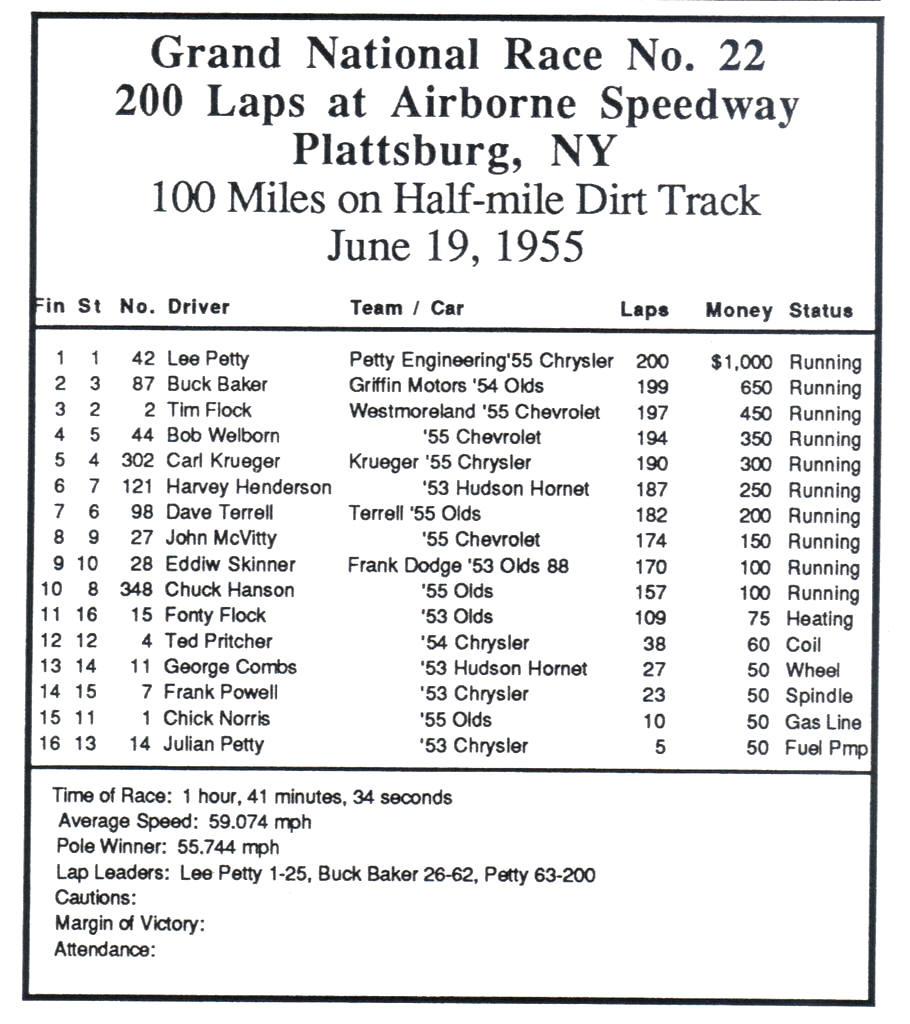
From the Plattsburgh Press Republican
The local paper did its best to build up the race for Broderick and partners.
BILL'S
WEEKLY COLUMN/BLOG PAGE
BILL’S BACK IN TIME
By Bill Ladabouche
THE GRAND NATIONAL RACE AT AIRBORNE IN 1955
WAS A NECESSARY SHOT IN THE ARM
PLATTSBURGH, NY – When Airborne Park Speedway was in its first year of operation, owners Burt Blake and Maurice Broderick were already looking to the future. Although the dirt track was not yet sanctioned by the National Association for Stock Car Auto Racing [NASCAR], they managed to secure a spot of the schedule of NASCAR Grand National northern tour for 1955. Up into the 1960’s, NASCAR persisted on having its top division do a northern schedule – perhaps to engender more interest in them and in the sport; and the New York portion of that schedule involved almost exclusively dirt tracks in the ‘50’s.

From the Plattsburgh Press Republican
The local paper did its
best to build up the race for Broderick and partners.
The local Plattsburgh Press – Republican put out an upbeat article in which it trumpeted that “top flight drivers from across the nation [would] stage a 200 - lap, 100-mile race at beautiful Airborne Park Speedway”. The paper would virtually promise the attendance of names such as Lee Petty of Randleman, NC; Buck Baker, from Charlotte, NC; Tim Flock of Atlanta, Ga„ the 1952 national champion; his brother, the colorful Fonty Flock; Dick Rathman, Daytona Beach, Fla.; and Blackie Pitt, Rocky Mount, NC.
The teams would arrive in Plattsburgh for the end of a taxing three – day race stretch throughout the Empire State; and the strain of this would have taken its toll by that Sunday. Russ Truelove, Bob Welborn, Gwynn Staley, Jim Lewallen, Gene Simpson, Paul Petit, and Al Weber were among the drivers who had dropped out by Sunday, June 19th; but, perhaps the biggest disappointment was New York State’s biggest NASCAR star, Jim Reed of Peekskill, who also had car failure. The previous night, the half – mile Fonda Speedway race had really damaged a lot of equipment.

From apl.ning.com Site
The fans were looking forward to
stars like Bob Welborn, who would go on to become “The King of the
Convertibles”; but Peekskill, NY
star Jim Reed [below – shown with a later car] was the Empire State standard
bearer. He would end up not making the show.

From the Three Wide Site
As it turned out, from all the promised names, only Petty, Baker, and Tim Flock materialized – and Flock had to go over to the Hubert Westmoreland Chevy to make the field. Those three were the biggest names in the field, as well as Bob Welborn. Third place points man Jim Paschal of high Point, NC was a no – show, but his car [#78 Oldsmobile] arrived and sat in the pits, unused. Fonty Flock did run a borrowed car, but he dropped out early. The fans got see all of the available makes of racing car at the time except, unbelievably, no one brought in a Ford. The field included a few Chevies, some Oldsmobiles, some Hudson Hornets, and several Chryslers. The big attraction was Carl Krueger’s Chrysler 300, mistaken;ly assumed by many as being from the hottest team in racing at that time. But Krueger, who was not sponsored by the Kiekhaeffer team, actually only raced in those New York races and maybe one more.
Courtesy of Tom Neff
Jim Paschal, running third in NASCAR
Grande National points at the time of the Airborne 200, did not show up at
Plattsburgh.
The car he had been using, the Helzafire #78 Oldsmobile and its team car sat,
unused, in the Airborne pits that night. [Below]

Bob Mackey Photo Courtesy of John Rock
Fortunately some hastily thrown – together teams that had not raced at the first two New York shows arrived in time for the Airborne event: Julian [JT] Petty, Chuck Hanson, Chick Norris, George Combs, Frank Powell, and Ted Pritcher. They were classic NASCAR field fillers, most of them lasting under forty laps. Petty, no close relation to Lee, would not be able to prepare his older Chrysler properly and was the first to drop out of the feature. Baker had to leave his Chrysler 300 on the sidelines and run a year – old car, the Griffin Motors Oldsmobile.

Source Unknown
With his current [and powerful]
Chrysler under the weather, Buck Baker showed up with his old faithful Griffin
Motors Olds
and nearly won the show. Below – Tim Flock did not have his Kiekhaeffer
Chrysler that night, either.

Tim Flock Homepage Photo
Petty, who was the fast qualifier at 55.744 M.P.H., led most of the race. He fell behind Baker in the middle of the race, only to b low by on lap 63 and lead the rest of the way. Baker held onto second, although he was occasionally pressured by Tim Flock. Typical of early era Grand National events, Petty was the car to make the 200 laps; Baker was one full lap behind, and Flock eventually fell back to three laps back in the Hubert Westmoreland Chevrolet. Two of the top ten finishers out of a sparse field of were as much as fifty laps down at the end. Results from other races, back down South, showed that the fields were oftentimes not much larger – just bigger names.
Reasons given for early departures included broken wheel, coil wire, overheating, and broken spindles and fuel pumps; but, most likely, the real reason was that NASCAR had only asked those guys to fill the field and broadslide their way around the track for enough laps to make it look good. And – “make it look good” was the order of the day. The Airborne 200 did feature the 1955 Grand National series champion, in Tim Flock, as well as runner – up Baker and the third place man, Petty. In fact, other finishers in the top 15 that year included Bob Welborn, Fonty Flock, Eddie Skinner, and Dave Terrell. The Airborne race netted Petty a whopping $1,000, with Baker grabbing $650 and the future champion earning $450.

Dargan Watts Photo
Lee Petty was clearly dominant at
Airborne with this car. Below – There were plenty of Fords in the
Grand National ranks at that time, but none made the show at Airborne
Courtesy of Pascal Cote
Drivers such as : Julian Petty, Hanson, Norris, Combs, Powell, and Pritcher did not even appear in the top 150 in the GN standings. This meant their winnings for the entire season [which probably included only around four races] were less than $100. The lowest finishers in the Airborne 200 all received $50. Even in 1955, that could not have even made costs. It is likely Big Bill France had greased their palms to make the trip up to the Canadian border and bail out the car – starved Plattsburgh race. Champion Flock would end up winning about $33,000 for that season, about five other men earned above $10,000. Considering this writer signed his first teaching contract for $5500 a year in 1968, that wasn’t too bad [except they were traveling and maintaining equipment].
Airborne Speedway could never really say that its 1955 Airborne 200 was an artistic success, although a good crowd was drawn. As was so often the case with those northern tour races, it was not repeated another year. It did serve to put the track in the spotlight, for that summer, with the likes of a Fonda Speedway – both being tracks scrambling to get started. And, from the looks of it – the NASCAR races helped both to a long and fairly healthy life.

From apl.ning.com Site
Gwynn Staley, shown herein the Hubert
Westmoreland Chevy two years after Plattsburgh, missed the show; but
Westmoreland’s 1955 entry was in with Tim Flock at the wheel. [Below] The
results of the Airborne 200.

From apl.ning.com Site
Please email me if you have any photos to lend me or information and corrections I could benefit from. Please do not submit anything you are not willing to allow me to use on my website - and thanks. Email is: wladabou@comcast.net . For those who still don’t like computers - my regular address is: Bill Ladabouche, 23 York Street, Swanton, Vermont 05488.
AS ALWAYS, DON’T FORGET TO CHECK OUT THE REST OF MY WEBSITE
www.catamountstadium.com
Return to the Main Page
Return to the Main News Page
Return to the All Links Page
Return to the Weekly Blog Links Page